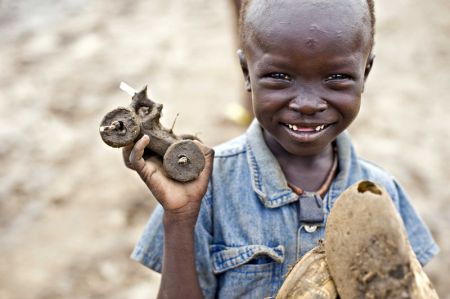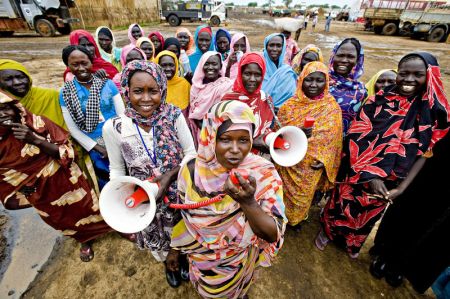
One year after its independence, South Sudan is facing its worst humanitarian crisis since the end of the war in 2005. Ongoing conflict and severe economic meltdown have taken their toll on the young country, where nearly half the population don’t have enough to eat.
While our media release goes into the details behind this alarming situation, the photos below, mostly taken at Jamam refugee camp (located near the border with Sudan), reveal the human side of the story.
Amir

Twelve-year-old entrepreneur Amir Nasser minds his stall at Jamam camp. While two small makeshift schools are now open for refugee children living in the camp, they can’t accommodate them all.
Keeping baby amused

One of the problems facing South Sudan is a major refugee crisis in the Upper Nile state near the border with Northern Sudan. Here, a young mother beats a tin can to entertain her young child at the Jamam refugee camp.
Hassan

Hassan Juma, 54, pictured with his three sons, fled their home in Bau, Blue Nile state in Sudan, when their village came under attack. “They reached our place in the middle of the night. Soldiers and police everywhere arresting people and attacking them. We tried to fight, and then when they saw we are fighting back, then the bombs came the next day at 11am. People ran from the bombs, and as soon as the soldiers saw it, they set fire to all the buildings. Some people who went back to get food were burned alive.”
Awab

Awab Allah, 4, proudly holds up his carefully constructed tank made of mud, syringes and razorblades. Awab, in a filthy denim jacket, loads the empty syringe casing with lengths of straw. He flicks the razorblade on his tank deftly, so it hits the back of the straw, making the missile fly through the syringe. It is a direct hit on his friend Adam’s tank. The boys laugh. “They are good fighters,” Awab’s brother Musab says. “They have seen so much war.”
Hawa

Hawa was forced to flee her home one day after giving birth to her daughter Amina. She and her husband Dan fled into the forest with their newborn baby wrapped in a shawl and their other four children. “To run after giving birth – I was suffering,” Hawa says. “I could only run a tiny bit, and then I had to rest. I was thinking, this baby is going to die. She can’t survive because of what is happening to us.”
The family walked for more than a month with their children. “We had to stop and rest in the middle of the day because the children were so tired,” Dan, 32, says. Somehow their shy little daughter survived, and his wife slowly recovered when the family reached the camp. “We are praying for peace so we can go home to our homes and be safe,” Dan says. “But for now it is better being a refugee. At home people were killing, they were bombing, they were shooting. Here we are not hearing the sound of the gun or of bombs. But our children suffer – there is no school for them to learn.”
Oxfam’s water and sanitation committee

Voluntary members of the Oxfam water and sanitation committee head into Jamam refugee camp to spread vital messages to young women over the loud-speaker about good hygiene practices, and to distribute female hygiene kits, which include underwear, soap and sanitary cloth.
Amani Silman Maujil, 22, WASH committee member and mother of three, says the water committee can be a bridge between Oxfam and the community. “There have been a lot of positive changes, first change is the use of pit latrines. We do home-to-home visits sharing Oxfam’s health advice on the importance of cleaning and washing the children, cutting nails, covering food, all to help prevent diarroeah and disease.”
Zeinab

Zeinab, 19, sits in the medical clinic at the Kilometer 18 refugee camp with her nine-month-old baby Melida. Melida is dangerously under-nourished and needs urgent medical attention.
Queuing for water

Children and women queue for the water points for pumping water at the Jamam refugee camp.
Find out more about the crisis in South Sudan and its northern neighbour.